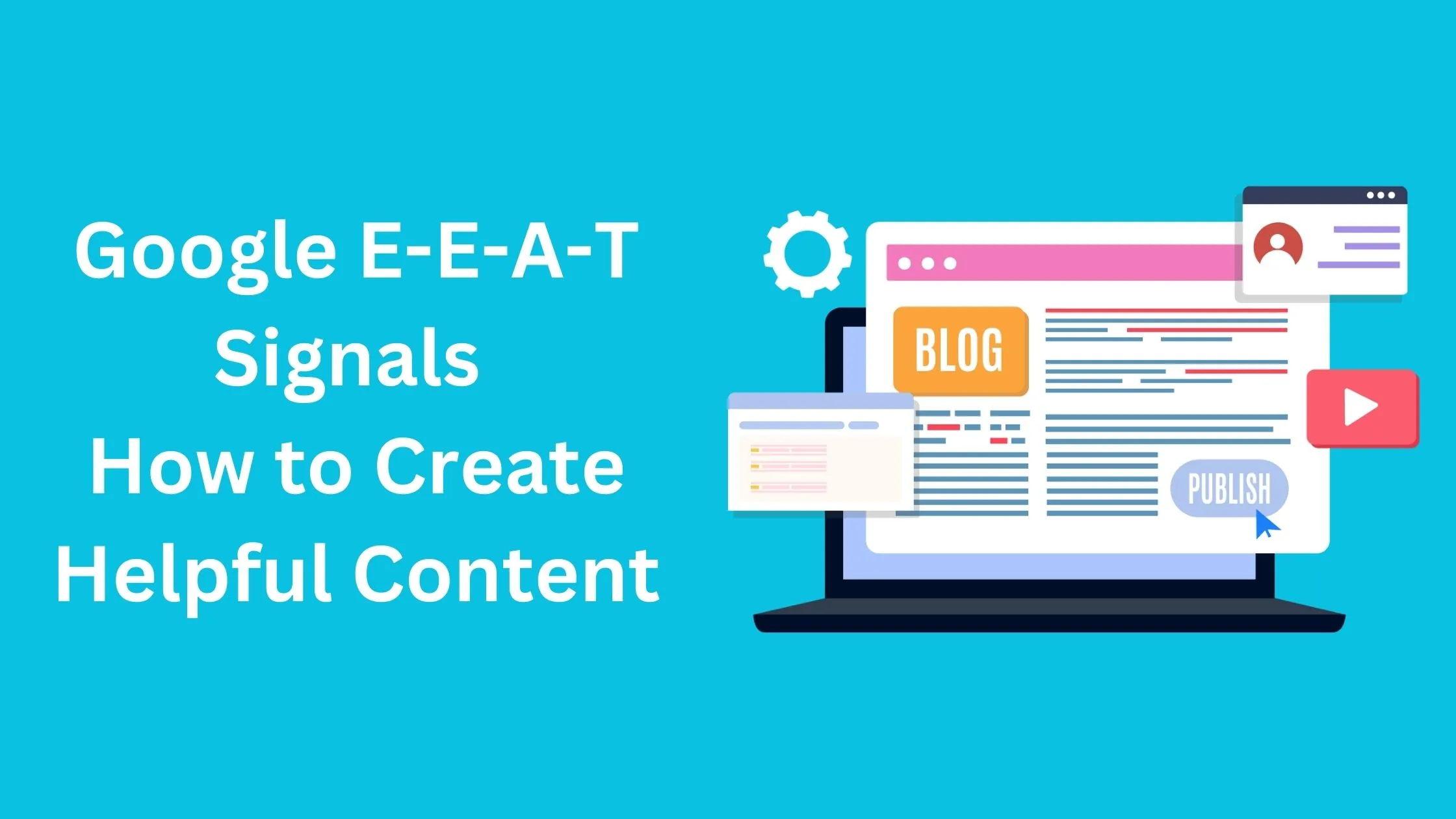Google E-E-A-T: How to Create Helpful Content

When creating content for the web, understanding Google’s E-E-A-T (Experience, Expertise, Authoritativeness, and Trustworthiness) is essential to reach audiences effectively.
The E-E-A-T framework is a major part of Google’s algorithm, helping ensure that users see high-quality, accurate, and useful information when searching online.
In 2023, Google introduced an additional “E” to the classic E-A-T formula—Experience—signaling the need for content creators to highlight firsthand knowledge and experiences.
This article will guide you through understanding what E-E-A-T is in SEO, why it matters, and how to use it to create helpful content that resonates with audiences and ranks well on Google.
What Is E-E-A-T in SEO?
E-E-A-T stands for Experience, Expertise, Authoritativeness, and Trustworthiness.
Google developed this framework to assess content quality and determine its relevance to user queries. The concept encourages creators to focus on valuable, reliable information over pure search engine manipulation.
In today’s competitive SEO landscape, incorporating E-E-A-T signals is a primary strategy for establishing credibility and improving search rankings.
But why does Google prioritize E-E-A-T?
Because it values content that can positively impact users’ lives by offering real insights, solving problems, or answering questions accurately and effectively.
Let’s explore each component of E-E-A-T:
- Experience: This “E” emphasizes firsthand experiences shared by the content creator. For instance, a product review from someone who has used it holds more weight than one from someone without direct experience. Demonstrating experience through authentic stories, examples, or personal observations can make content more credible.
- Expertise: This criterion is about specialized knowledge. Google expects content in sensitive areas, such as finance, health, and law, to come from recognized experts. Expertise can be established by showcasing qualifications, credentials, or evidence that proves the author’s skill in a particular subject.
- Authoritativeness: Authority refers to the reputation of the content creator or website. Google looks at external recognition, such as links, mentions, and overall online presence. The more credible sources endorse or refer to your content, the more authoritative it appears.
- Trustworthiness: Trust is the foundation of E-E-A-T. Content should be accurate, well-cited, and free from errors. Trustworthiness can also be built by having transparent policies, like privacy statements, and making sure the content aligns with user needs.
Why Is E-E-A-T Important for SEO?
E-E-A-T has become a crucial part of SEO strategy as it aligns with Google’s core goal: delivering the best information to users.
As search algorithms evolve, Google increasingly favors pages that exhibit clear E-E-A-T signals, rewarding them with higher search rankings. This focus on high-quality, helpful content enhances user experience and encourages transparency.
Websites with strong E-E-A-T signals are often seen as more reliable, fostering trust with users.
Since Google updated its quality guidelines, E-E-A-T has become an important factor for sites across many sectors. Content creators and SEO professionals aiming for sustainable results should understand that SEO isn’t just about keywords but also about creating reliable, helpful content that genuinely serves users.
E-E-A-T Guidelines to Write Helpful Content
Creating E-E-A-T-compliant content isn’t complex but requires a deliberate approach to ensure accuracy, transparency, and engagement.
Below are practical tips on how to write helpful content that adheres to Google’s E-E-A-T guidelines:
1. Showcase Experience through Personal Insights
- Including firsthand experiences within your content makes it more relatable and credible. Google values content that draws from real situations, as it’s often more reliable and useful.
For example, if you’re writing about a travel destination, including personal anecdotes, photos, or reviews can improve the content’s E-E-A-T score. - Always mention personal encounters when appropriate, as this aligns with the primary keyword “EEAT” and demonstrates your content is driven by genuine knowledge.
2. Establish Expertise with Clear Qualifications
- For certain types of content, especially in fields like health, finance, or legal, establishing expertise is critical. If you’re covering these topics, make sure the author is qualified or that you reference credible experts. Adding an author bio that lists relevant credentials or professional background can strengthen the content’s perceived expertise.
3. Build Authority through Quality and Recognition
- Google examines external signals like backlinks, citations, and mentions from reputable sites to measure authority. Building a content network, securing mentions on other credible sites, and generating valuable, shareable content are all methods to strengthen your authority.
- Avoid low-quality links, as these may undermine authority. Instead, focus on earning organic links through original research, industry studies, and collaborations.
4. Prioritize Trustworthiness with Accurate and Transparent Information
- Accuracy is non-negotiable in content creation. Ensure that data, statistics, and claims are properly cited and verified. Providing sources and linking to original research demonstrates transparency, boosting trustworthiness. Avoid misleading or exaggerated claims, as this can erode credibility and user trust.
5. Optimize Content for Readability and Engagement
- Simple language, a clear structure, and concise sentences are key. Avoid overloading your content with complex terms or overly technical details, as this can make it challenging for general audiences to engage.
- Break up long paragraphs, use subheadings, and incorporate bullet points when possible. This not only improves readability but also aligns with Google’s helpful content guidelines, ensuring content serves the reader’s needs.
6. Follow Google’s Helpful Content Guidelines
- Google’s helpful content guidelines urge creators to prioritize user needs. Avoid keyword stuffing, excessive internal linking, or clickbait titles. Aim for natural keyword integration by using relevant terms.
- Address real user questions in your content to make it more useful and SEO-friendly. Utilizing tools to identify popular questions around “your niche” can help you align with common user interests.
E-E-A-T Best Practices for SEO Strategy
Crafting an SEO strategy around E-E-A-T is about integrating quality, accuracy, and user-centeredness into your approach.
Here are best practices to ensure E-E-A-T compliance in your SEO strategy for content:
1. Conduct Thorough Research on the Target Audience
- Understanding your audience’s needs, preferences, and common questions is fundamental to creating helpful content. The more your content aligns with their expectations, the more effective your E-E-A-T signals will be.
2. Use Authoritative Sources and Cite Properly
- Linking to reputable sources adds credibility to your content. For example, if discussing health or finance, linking to government sites, medical journals, or financial news sites can validate your points and boost E-E-A-T.
3. Keep Content Updated
- Outdated content is a red flag for both users and Google. Regularly review and refresh your content to keep it current. This is especially important in industries with rapid changes, such as tech, finance etc.
4. Encourage User Engagement and Feedback
- Inviting comments, questions, and feedback on your content can improve user experience and demonstrate engagement. This helps build a positive reputation for your website, strengthening E-E-A-T signals over time.
5. Optimize On-Page Elements for Clarity and Simplicity
- Meta titles, descriptions, headers, and images should all contribute to a clear, coherent experience for users. Avoid unnecessary complexity; keep on-page SEO elements straightforward and relevant to the content’s topic.
Final Thoughts: Building Content that relevant with E-E-A-T
Google’s E-E-A-T framework encourages content creators to focus on quality, relevance, and user trust.
By prioritizing Experience, Expertise, Authoritativeness, and Trustworthiness, you not only create content that ranks well but also build a credible online presence that attracts and retains audiences.
Following these guidelines, you’ll be well on your way to creating content that not only meets SEO standards but also genuinely serves users’ needs.
In a digital landscape dominated by information overload, creating helpful content that stands out is essential. When done correctly, E-E-A-T doesn’t just boost rankings; it builds lasting relationships with users who see your content as a reliable source of information.
Whether you’re a business, a content creator, or an SEO professional, incorporating E-E-A-T into your strategy is a valuable investment in both search visibility and user trust.
Related Articles
Guide to Content Creation
How to Find & Create Evergreen Content That Brings Traffic for Years

With 5+ years of SEO experience, I’m passionate about helping others boost their online presence. I share actionable SEO tips for everyone—from beginners to experts.

